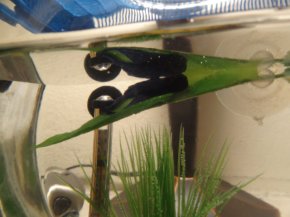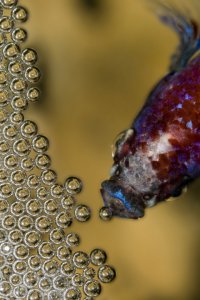
 Walking through the betta section of a pet shop you may notice a thick white foam spread across the water’s surface of the fish cups. Or perhaps you’ve seen it in your own tank, a lining of bubbles and white. This is a bubble nest and it is created by your Betta fish. The seasoned betta keeper knows that these nests are created by a mixture of fish saliva and a gulp of air, sticking the bubbles together in a still water area selected by their fish. Although more common with males, female Betta splendens have been known to make bubble nests as well. They are defensive of their hard work and may even attack you or flare to keep you away. Yet, as common as these nests are there are still many misconceptions of them.
Walking through the betta section of a pet shop you may notice a thick white foam spread across the water’s surface of the fish cups. Or perhaps you’ve seen it in your own tank, a lining of bubbles and white. This is a bubble nest and it is created by your Betta fish. The seasoned betta keeper knows that these nests are created by a mixture of fish saliva and a gulp of air, sticking the bubbles together in a still water area selected by their fish. Although more common with males, female Betta splendens have been known to make bubble nests as well. They are defensive of their hard work and may even attack you or flare to keep you away. Yet, as common as these nests are there are still many misconceptions of them.
Some people believe that the thicker, longer, and larger the bubble nest the happier the Betta fish. This idea tends to go hand-in-hand as evidence of health. Stores may even defend the poor quality of their fish set-ups by referring to the bubble nests their bettas create as a sign of the fish’s well-being and enjoyment of a small, dirty, space.
Bubble nests are not a sign of happiness. They do not mean a fish is healthy, either. They are made only out of instinct. Size and shape of bubble nests change depending on the individual fish. Some nests are thick and distinctly white while others are long and clear looking. The only reason fish have instincts to create bubble nests is because of their need to breed. Even sickly fish will prepare in case a mate comes along. The bubbles are used to house fertilized eggs until they are ready to hatch.
Not all Betta fish species create bubble nests, though. Species that do not create bubble nests are mouth-brooders, meaning that they hatch fry—the name for their babies—from their mouths rather than creating a nest for their eggs. In fact, of the currently 73 identified Betta fish species only 18 are bubble nesters and a few within that group may occasionally mouth-brood in certain circumstances. Betta splendens, the species most people find in stores and refer to only as bettas, are surface bubble nesters but some other species, such as Betta livida are submerged bubble nesters. The conditions for each Betta fish to create bubble nests vary, depending on the species and individual fish. For example, some Betta splendens will not make a bubble nest outside of breeding conditions and some may not make one at all.
 It is important to remember that just because a fish is building a bubble nest it does not mean that fish is lonely or need of a mate. Breeding fish is a fun hobby but it is a hobby with serious responsibility attached. Betta fish can easily lay 500 or more eggs, each of which has a potential to grow into an adult fish. Unless you are interested keeping or finding homes for so many individual fish, while keeping all males separate from all females, it is not a good idea to even attempt to breed bettas. Breeding is difficult and beginners have uncertain luck at success, so getting into that part of the betta keeping hobby should be a choice made after much research, an established high budget, and all equipment is purchased—not after seeing a bubble nest. Bubble nests are not a reason to get your pet a mate
It is important to remember that just because a fish is building a bubble nest it does not mean that fish is lonely or need of a mate. Breeding fish is a fun hobby but it is a hobby with serious responsibility attached. Betta fish can easily lay 500 or more eggs, each of which has a potential to grow into an adult fish. Unless you are interested keeping or finding homes for so many individual fish, while keeping all males separate from all females, it is not a good idea to even attempt to breed bettas. Breeding is difficult and beginners have uncertain luck at success, so getting into that part of the betta keeping hobby should be a choice made after much research, an established high budget, and all equipment is purchased—not after seeing a bubble nest. Bubble nests are not a reason to get your pet a mate
There are owners who feel guilt in destroying a bubble nest. Their fish did work hard to create it and is rather protective of it, after all. But in order to change water and maintain high quality living conditions for your fish, bubble nests will be destroyed with a water change and that’s okay! Your fish will make a new one if it desires. It will feel no sadness in its loss. Keeping a healthy aquarium is more important than keeping a bubble nest, even if it is an impressive looking one.
No bubble nest is not a sign of poor water conditions, unhappiness, or age any more than the creation of a bubble nest is. While they may be fun to look at and exciting to see built, these foamy white clusters are by no means a reflection on your achievement with your fish.









